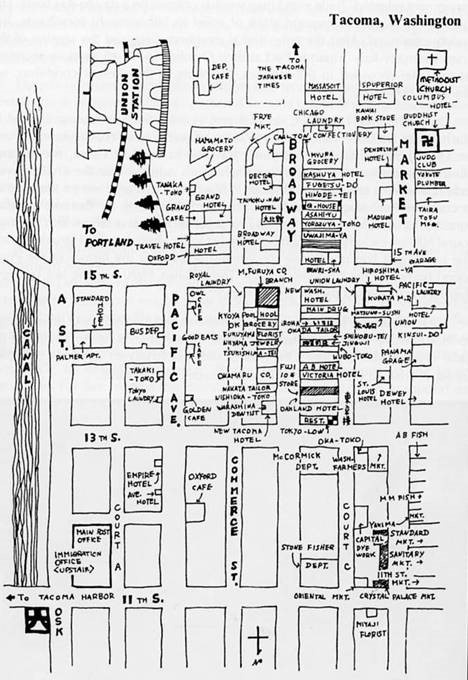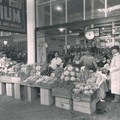And here is an extraordinary document from an exceptionally rare source. This hand drawn map produced by Kazuo Ito shows the extent of Tacoma’s Nihonmachi or Japantown about 1920.
The individual listings show Japanese operated businesses, many of which also served as family homes for the 1700 residents of Japanese ancestry living in downtown Tacoma. These were the townies-the merchants, innkeepers, restauranteurs, grocers, teachers, barbers, tailors, photographers, doctors, mechanics, apothecaries, florists, bankers, porters, and artists who made up Tacoma’s thriving Japantown.
Joe Kosai, who grew up in his family’s hotel on Pacific Avenue and later taught math for Tacoma Public Schools, remembered going down to the theater district all by himself on Saturday mornings, getting help from the usher into his seat where his knees didn’t bend and his sneakers poked out into the aisle, and then watching cartoons, cowboy movies, and sci-fi serials until his eyes and neck hurt from looking up at the giant screen. He was six.
Japantown was anchored by the grocery stalls and restaurants around the public markets between 11th and 13th on Market Street to the North and the many hotels clustered near Union Station on the South. In between a busy neighborhood went about its daily routines, morning delivery wagons, kids to school, businesses opening with the turn of a key and the flip of a sign, lunchtime rush at the cafes, the early afternoon papers arriving, grocery shopping and streetside visiting, after school sports and language school, travelers wandering into the barber shops, and hotel lobbies from the evening trains at Union Station, then the lights of the restaurants and clubs take over the streets and the shopkeepers close up shop and head upstairs for dinner with the family.
Tacoma’s nihonmachi peaked in population about 1920, as did their country counterparts in the Fife Valley, each reporting a resident population of just over 1300 in the federal census. But as Kazuo Ito’s wonderfully detailed book on the History of Japanese Immigrants in North American points out, the count did not include migrant agricultural workers, maritime sailors and dockworkers, and the many nomadic travelers and adventurers who wandered the Japantowns of the far west. Tacoma’s Japantown was culturally dense with a Buddhist temple, churches, a language school, judo dojos, Japanese language newspapers and theaters, private tearooms, and social clubs.
Per capita Tacoma had one of the largest nihonmachi’s in America and it was that fact that drew the attention of Congressman Albert Johnson, chairman of the powerful House Committee on Immigration and Naturalization. Tacoma, Fife and the south sound region were in his congressional district and he was fiercely opposed to their presence and threatened by their enterprise and growing prosperity. Before most of the nisei (American born) Tacomans that would be interned at the start of the Second World War were even born, Congressman Johnson was crafting federal legislation that would block their citizenship, landownership rights, and basic civil law protections. The seeds of destruction for Tacoma’s nihonmachi were planted not in the days before the bombing of Pearl Harbor in December 1941 but in the mind of Albert Johnson just after the First World War a generation before.
Politics and prejudice aside, the nihonmachi remained the first neighborhood travelers to Tacoma by train would see. Through the 1920’s and 30’s, the automobile undeniably took a bite out of the railroads but most working folks, traveling families, and wandering young sight seekers still went by train and traveled in cities by streetcar. The hoteliers, cafes and townies of Japantown served them best, with good food at a fair price, clean sheets and a comfortable bed in a safe room and a steam bath, haircut, shave or directions with no questions asked unless you ask.
When it came to fresh food locally grown, the nihonmachi fed Tacoma. From just cut celery to sea cucumber row, the discerning handling of food was a basis for trust between the Japanese community and the city’s streetcar neighborhoods and kitchens. At the public market, the Japanese grocers were not relegated to the back stalls. Their mouthwatering displays of green vegetables, hand picked berries (sprinkled continually with a fine spray of water), and fresh cut flowers were prominently in the front stalls where they could best attract shoppers in off the busy street.
So back to Kazuo Ito’s amazing map of Tacoma nihonmachi, back to the smells of steamed vegetables and waxy hair tonic, to the sounds of markets and news stands. Back to Joe, safe in his seat at six years old in a vast, fantastic movie theater in the middle of an even bigger city that feels completely like home to him.
*This article was originally published on Tacoma History on June 10, 2016.
© 2016 Michael Sullivan













